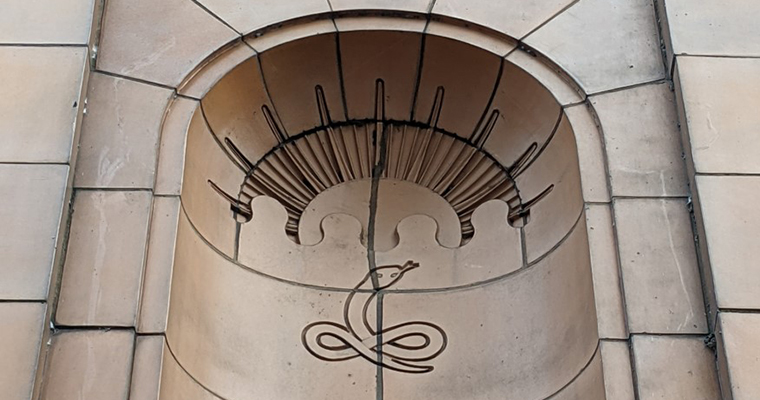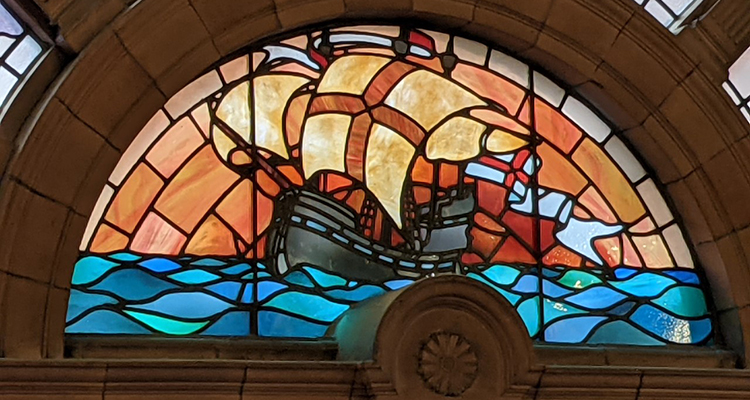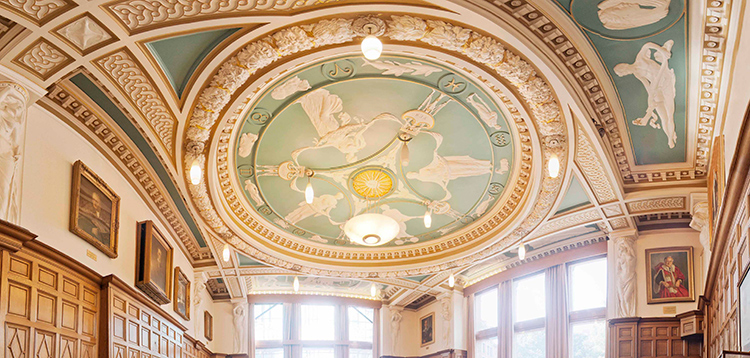Our campus truly is beautiful this time of year.
Look down and see red and yellow leaves beneath your feet. Look up and see Autumn skies infused with colour.
But have you ever looked – properly – at some of our University buildings? Because, sometimes, there’s (much) more there than meets the eye.
Take, for example, the wonderful terracotta-bricked Sackville Street Building. It’s walls, doors and windows are crammed with meaning. But hurry past on your way to the classroom, lab or office, and you can easily miss it.
So here we take a closer look at the fascinating, surprising – and sometimes slightly odd – symbols of Sackville Street Building…

The antelope and the lion
Let’s start with one of Manchester’s most famous, and important, motifs: its coat of arms.
Between floors B, C and D you’ll find incredible stained-glass representations of the instantly-recognisable crest. The central shield hosts three diagonal bands – a popular myth being they represent the rivers Irwell, Irk and Medlock, the latter of which flows, hidden from view, right by Sackville Street Building (the shield is actually taken from the coat of arms of the Grelley family, the former Lords of the Manor of Manchester) – and also features a ship in full sail, highlighting Manchester’s renowned trading might (more on which later).
An antelope and a lion, both bearing the red rose of Lancaster, support the shield, and symbolise peace, harmony, courage and discipline; and bravery and strength, respectively.
Also featured is perhaps the best-known of Manchester’s symbols. The bee denotes industry and a strong work ethic, presenting the city as a real hive of activity. On the coat of arms you’ll find lots of busy bees circling a globe, again representing the city’s trading power, its scientific achievements, and the exporting of its industry around the world.
The Latin motto “Concilio Et Labore”, which translates – loosely – as “by wisdom and effort” or “by counsel and work”, lies at the bottom. Fitting, we think, for a city of such ingenuity and discovery.

A Sackville snake
Speaking of crests, when you enter the building’s grand Sackville Street entrance you’ll likely spy a number of banners sporting the University’s own coat of arms.
This emblem dates back to 2004 and the merger that formed the institution we know today, and adopts aspects from the crests of both the Victoria University of Manchester and UMIST (University of Manchester Institute of Science and Technology).
It includes, for instance, UMIST’s crowned lion – a symbol of strength and courage – and a sun against a blue background, drawn from the Victoria University of Manchester’s shield and depicting enlightenment. Fittingly, the current arms includes three prominent bees – underlining the University’s links to the wider city – and the motto “Cognitio, sapientia, humanitas”, meaning “Knowledge, wisdom, humanity”.
On either side of the Whitworth Street doorway, meanwhile, you’ll find a curious collection of engravings. One depicts (again) a rising sun, and beneath it – intriguingly – a knotted serpent.
Though the size and grandeur of Sackville Street Building might well evoke the magic and mystery of Hogwarts, we reckon the snake is more a representation of wisdom than anything to do with House Slytherin (unfortunately). Indeed, the sun and snake appear in this formation on the old Victoria University of Manchester crest, and, interestingly, the University’s first-ever Students’ Union magazine, published in 1917, was titled the Serpent!

On the other side, three stripes again represent the city’s three rivers, and sit beneath another ship motif. The ship is a popular Manchester symbol, depicting trade and enterprise, and even appears on the crests of the city’s two biggest football clubs: United and City.
The most striking ship in Sackville Street Building, however, has to be the orange and blue stained glass vessel that sits, in full sail, above the door to the Sackville Street entrance.

Gods and monsters
Step from that doorway, turn around and look up to see some of the more beguiling Renaissance features of the building – the protruding faces of gods, wizards, scholars and monsters.
Now what these faces actually represent isn’t totally clear… but we can certainly take an (educated) guess.
Peering out between the layers of windows, the sculpted heads are exceptionally detailed, exquisitely carved. Are they scholars? Well, that would certainly make sense.
Perhaps they’re Greek gods? Again, this might be so – especially because the style is found, in abundance, in perhaps the most extravagant of Sackville’s rooms: the Council Chamber.
Here you’ll find beautifully decorated ceiling panels, the central one depicting Helios, the sun god, surrounded by the four figures of wisdom, understanding, council and knowledge. Between these are the four seasons of spring, summer, autumn and winter, and the Zodiac signs for each of the 12 months.
The fruits of the Earth line the outer rim, and in one of the side panels can be found Eos, the personification of dawn, driving her two horses, brightness and lustre. Around the room stand eight caryatids, representing the virtues of prudence, justice, fortitude, temperance, patience, vigilance, faithfulness and chastity.

Terracotta delights
Back outside; and beside the mysterious faces you’ll find many more enchanting figures – signifying, we assume, the fundamental need for learning, education, and self-improvement.
Among the eye-catching terracotta reliefs are cherubs (depicting the advancement of the young, perhaps?), and all manner of carved vegetation and foliage.
Look closely and you’ll spot the arresting figure of the mythical griffin, a legendary creature with the head and wings of an eagle, and body of a lion. The beaked beings represent wisdom, strength and cunning.

Peer closer still and you’ll notice wizard-like reliefs, mouth aghast, with foliage and scrolls emerging from hair and beard. Is this a representation of the passing of wisdom, of ideas being ‘planted’ into the minds of the young? Or could it be the famous and mysterious Green Man, the Pagan symbol of life, death and rebirth?
Notice, too, on the black gates and brass Art Nouveau door handles what appear to be, perhaps… kidneys? The organs are linked to the innermost stirrings of emotion, our secret thoughts and as metaphors for morality and inspiration.

Surprise, surprise
While not all symbolic meaning is immediately clear, what’s for sure is that Sackville Street Building is packed full of it.
And we haven’t even touched on the more obvious (but certainly no less interesting) stained glass window celebrations of much-revered names dotted around the grandiose Entrance Hall (see Newton for mathematics, Shakespeare for literature); nor the wonderfully-detailed panels of influential figures and spectacular engineering feats shining from the colourful windows of the Great Hall.
Nor, of course, could we have possibly covered every symbol in and around this great building. Do you know of any more?
Sackville Street Building. It’s – quite literally – full of surprises.
If you enjoyed this post, be sure to subscribe on our homepage to keep up to date with the latest posts from The Hub.
Words: Joe Shervin
Images: Joe Shervin, The University of Manchester

Comments
7 responses to “Wizards, monsters, ships and bees: The symbols of Sackville Street Building”
It would have been nice to mention the architects and the manufacturers of the stained glass and terracotta.
I studied in the Sackville Street Building (what was UMIST) and it is such a shame that it is closed and empty. You just know it will end up being an apartment building for people with too much money. It should be re-instated.
I enjoyed reading about the shield 🛡 of Manchester, when I was picturing my life’s CV I wanted to understand the guiding thoughts. This explains all about Manchester’s appreciation of where it is and has been and will go to!
The heraldry is interesting but not entirely accurate. The coat of arms of the city of Manchester is blazoned without the crest which is a globe covered in bees symbolic of worldwide trade and industry – this has given rise to the celebrated Manchester Bee but whether it is also granted as a separate badge as well I do not know.. the knotted snake or serpent nowed is the famous crest of the Cavendish family Dukes of Devonshire who for many years were chancellors of the Victoria University of Manchester although how the serpent became incorporated into the University coat of arms I do not know. The rising Sun is likely indicative of growing enlightenment. The mural crowned lion crest of UMIST is a reference to the City of Manchester. The lion is holding a torch the tradional symbol of education again enlightenment used on school and library signs until about 1960. Likely it refers to the idea of enlightenment as in the prayer, the general collect for all emergencies which begins …” Lighten our darkness O LORD we beseech Thee…”
The diagonal lines(bendlets in heraldic terms)are taken from the arms of the Grelley family,feudal lords of Manchester.
The Dukes of Devonshire were large landowners to the south of the city, hence Devonshire Street and Cavendish Street.The dynasty is also memorialised inthe name of the Glossop-Sheffield road,the Snake Pass
The terracotta work is from the Leeds firm of Burmantofts,the stained glass W.J Pearce.
Is there a record of all the stained glass in the building?
Heraldry
Although the antelope and the lion may possess the qualities as given, in this case the heraldic, chained, antelope is obtained from the Beaufort family and represents the Duchy of Lancaster as do the red roses with which it is charged. The golden lion depicted on hind legs is the lion of England. The crown is battlemented and is known as a mural crown. Apparently this type of crown was originally awarded to the first soldier to scale a walled city. Consequently this type of crown is only used in Civic heraldry to bodies designated as Cities.
The statement that the three diagonal lines(bendlets) represent rivers is incorrect .If it had been intended to depict these, horizontal lines with wavy edges would have been depicted and the colour used would have been blue. (azure).In fact the bars are taken from Grelley family arms; the Grelleys were feudal lords of Manchester.
The arms and crest were granted to Manchester on 1 March 1842,about the same time as Manchester achieved City status.
It would be satisfying to say that the knotted snake in the University arms represented the serpent tempting Eve to eat from the tree of Knowledge, but the nowed snake represents the Cavendish heirarchy, Dukes of Devonshire large local landowners. The family are also commemorated by the Snake Pass which crosses moorland traditionally held by the family.
The stained glass was the work of W.J Pearce.
Architecture
To answer questions asked about the building, the terracotta work was carried out by Burmantofts of Leeds, probably the leading exponents of this type of work.
The architects were Spalding and Cross. Their etched glass on the exterior of the building and depicting the building is well worth viewing. The architects other major commission in Manchester was Victoria Buildings where the partnership were given instruction to keep architectural detail to a minimum since they were designing artisans dwellings. With this building they were given a free hand.